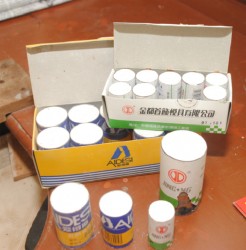Rajkumar Seeram is hedging his bets in jewellery-making, an industry which these days, given the recent drop in gold prices has a fair measure of uncertainty.
A jeweller by profession, he readily admits that the competition has caused him to look beyond jewellery-making for a living.
His current pursuit of marketing jewellery moulds, a trade he discovered in Suriname several years ago, brings him a fair living.
Jewellery casting is an age-old process of making jewellery pieces by pouring liquid metal alloy into moulds. It is usually commonly referred to as “lost-wax casting” because the casting mould is created using a wax model that is melted away to leave a hollow chamber in the middle of the mould. The technique has been used for thousands of years, and is still widely used today by both master craftsmen and home crafters to make precise reproductions of original jewellery pieces.

The growth of the jewellery industry in Guyana has helped to popularise the practice of jewellery casting. It provides the advantage of enabling the jeweller to turn out hundreds of intricate designs in various pieces of jewellery and Seeram is one of a handful of people in the local jewellery sector who has been able to find markets for the moulds.
Before that he simply made jewellery and while he still keeps his hand in based on the orders that he gets, it is the moulds that interest him most these days. The focus of his interest has shifted from the distributor in Suriname from whom he once bought the moulds, to the manufacturers in China whose name he declines to disclose.
Last year’s GuyExpo afforded him the opportunity to significantly broaden his client base. These days he sells the moulds as far afield as Trinidad and Tobago where the jewellery industry is similarly organised.
Seeram’s 33 Howes Street, Charlestown address advertises his services both as a jeweller and a seller of the jewellery castings. Inside, it is not difficult to tell where his priorities lie. There are rows upon rows of boxes containing the moulds. Stabroek Business also got a glimpse of one of the distributor catalogues sent to him by his Chinese business contacts. Once you peruse the catalogue you understand the commercial value of the moulds.
Seeram is a hard-nosed businessman who is used to taking risks. Having recently opened a second branch of his operations at Vreed-en-Hoop, West Coast Demerara, he was forced to close it shortly after. The move, it seems, had not benefited from a sufficiently careful survey of the market and the earliest indicators of failure emerged shortly after the investment was made.
The past two years have been spent pursuing a more careful study of the market. That, it appears, has paid off. Jewellers in Essequibo and Berbice have been responsive and the Trinidad market is doing “reasonably well.”

Seeram’s customers and close friends call him ‘Tailor’. It is a sobriquet that derives from his pursuit of an earlier profession. At the age of 11, he was apprenticed to a tailor. Tailoring became an after-school pursuit. After several years of tailoring, a profession at which he did not do well, he joined his younger brother in the jewellery business in 1989.
He has sold moulds in fits and starts, purchasing in Suriname and selling to jewellers in the city then quitting after he discovered that a competitor had entered the market. Afterwards, the popularisation of the jewellery trade caused him to return to the business of selling moulds. That too was short-lived.
A windfall secured from his role in a construction contract about five years ago yielded sufficient capital for him to return to the industry. He has remained in the business ever since, marketing moulds to a growing clientele.
Communication with his Chinese suppliers proceeds through conventional mail and the internet. Catalogues containing scores of jewellery designs are sent to him and these are distributed to his customers. He then communicates his orders back to China and awaits delivery. Payment must be made to the supplier in full before his supplies leave China. It often takes up to four months for supplies to reach Georgetown from China and, he adds, “three to four days to clear customs”. At the time of this interview, a shipment which had arrived several days earlier, on May 16, was still to be cleared. It appeared that the officer who had commenced the clearance process had been reassigned.
Other snags occur, like the dispatch of the wrong orders from China. That worries Seeram. Clients are sometimes unforgiving of those kinds of errors and there is really is no way of preventing such episodes from time to time.
Local jewellery taste determines demand. Seeram said ladies’ choices in earrings include flowers, animals and intricate designs. His own experience as a jeweller enables him to offer critical advice to his customers including design anomalies and volumes of gold required for working with particular moulds.
Inside his shop there is a modest display of some of his own handiwork, small items that cater to the walk-in customer. He has a few regular customers too, who sometimes take their own gold. In other instances he supplies the gold. These days he is more insistent on “advances”. Times are tough and it is not uncommon for well-intentioned customers to place orders and simply not return for the finished product. His own customers are usually reliable but he cannot ignore the experiences of others in the jewellery trade.




